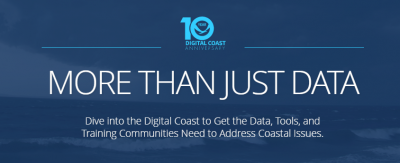
BEAUFORT – Digital Coast — a website filled with data, and the tools and training to help make sense of the data — was created to help communities in coastal zones approach a range of challenges such as sea level rise and storms.
Adam Bode, senior geospatial analyst and regional coordinator for National Oceanic and Atmospheric Administration’s Office for Coastal Management based in Charleston, South Carolina, led in October a daylong NOAA Tools Training, the first of its kind, at the NOAA Fisheries Beaufort Lab to help coastal management professionals learn more about the website and how it can help them.
Supporter Spotlight
The multi-faceted website is organized in sections: About, Data, Tools, Training, Topics and Stories.
“It’s a mixed bag of different tools, trainings, webinars and resources meant to help you step through and better understand natural infrastructure and other topics that we have on the Digital Coast,” Bode said.
Bode said during the training session that what sets Digital Coast apart from other one-stop shop information portals is that “we’re really focused on aggregating and collecting, collating resources really meant for the coastal zone management community.”
The Digital Coast was first released in 2007 and is managed by NOAA’s Office for Coastal Management. Bode said that the office works with partners to try to provide unbiased, relevant information and tools.
Supporter Spotlight
“More than just data” is a slogan for Digital Coast, Bode continued, because, while data is the foundation of Digital Coast, there are also training resources, access to tools and a variety of other ready-to-use resources covering a number of different topics, all structured around the needs and input of the users.
Digital Coast houses more than 70 terabytes of data, including high-resolution elevation data, land cover data and orthoimagery, or remotely-sensed aerial photography that has been geometrically corrected or adjusted for lens distortion and other aberrations.
“Tools is another main section of our website,” Bode said, adding that providing access to curated lists of tools is the goal. There are more than 50 different tools that can be filtered, categorized based on geography and topic of interest.
“Another core component of the website is our training,” Bode explained. There are scheduled trainings that are instructor-led, online and mixed delivery, which is a combination of webinar with some hands-on training as a follow-up.
In addition to scheduled courses, there are on-demand learning products that include a variety of self-guided resources, case studies, 47 publications, a number of quick references and the video and webinar sections are continuously being expanded.
There are currently 10 topics in the Topics section, including adaptation strategies, natural infrastructure and vulnerability assessments, with plans to add more in the future, Bode said.
“The overall general approach taken with the Digital Coast is that it gets people the foundational data and resources that they need,” he said.

Bode recommended visiting Tips for First-Time Users as well as the frequently asked questions, or FAQs, on the main page of Digital Coast for those who are new to the website.
Bode said in an interview after the training session that the training at the NOAA Lab exceeded expectations.
“The size and diverse nature of the attendees provided a great opportunity for NOAA to work with and hear from our target audiences. Attendees appreciated the hands-on format, which elicited great discussions. We look forward to extending this type of training to others within the state and region,” he said.
Bode said that the website was developed to meet the unique needs of those who make decisions about coastal resources, including town planners, developers and coastal conservation groups, to name a few.
“Content on the site comes from many sources, but being relevant to this audience is the requirement. The Digital Coast Partnership, which is made up of user groups such as the American Planning Association and the National Association of Counties, helps ensure this relevance, providing user insight and feedback,” he said.
Bode said that while designed for specific issues and audiences, the public will find many Digital Coast resources to be helpful. “They should check out the Stories from the Field section of the website. Here, nearly 140 examples of how Digital Coast resources help coastal communities can be found. A handout about North Carolina and the most used Digital Coast resources for this state is also available.”
Examples of Stories from the Field include New Jersey engaging communities in hazard mitigation planning through the use of vulnerability assessment tools as well as planners along Florida’s Gulf Coast using the Sea Level Rise and Coastal Flooding Impacts Viewer data to help identify the effects of shoreline armoring on seagrass habitats.
Those new to the site should also visit the Digital Coast Academy, Bode added. “This section contains nearly 200 resources, from in-person training to quick references guides and videos, all designed to help people understand their coast and make better decisions about the future of their coast. After all, that’s what the Digital Coast is all about – making the right decisions about the future of our nation’s coasts.”

Whitney Jenkins, coastal training program coordinator with the North Carolina Coastal Reserve & National Estuarine Research Reserve, coordinated the training session with Bode and Jennifer Dorton, who at the time was with the North Carolina Sentinel Site Cooperative, part of a NOAA effort to provide coastal communities and resource managers with information on the potential impacts of sea level rise on coastal habitats. The North Carolina site encompasses Carteret County and parts of Onslow and Craven counties.
Jenkins said, “The Reserve was very excited to bring this opportunity to coastal North Carolina professionals to showcase the resources NOAA has developed to support coastal management. A big thank you to Adam Bode with NOAA’s Office for Coastal Management for leading the training and the N.C. Sentinel Site Cooperative for sponsoring this event.”








